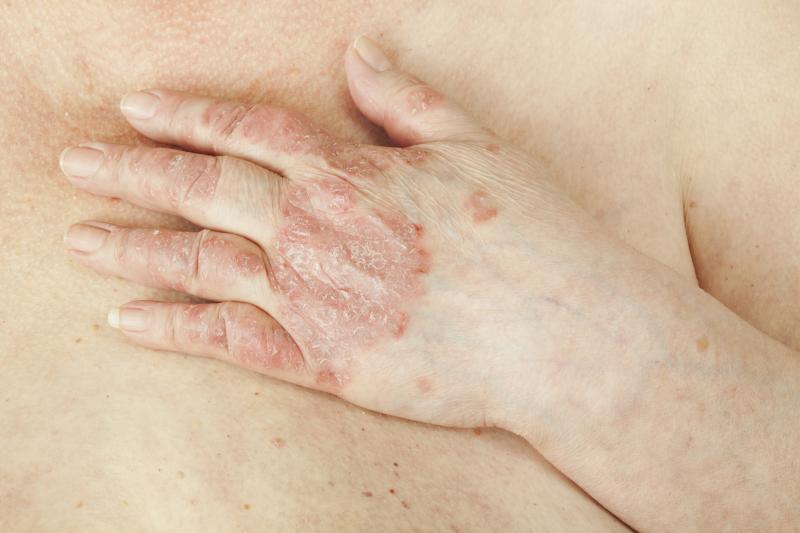Best biologics for psoriasis? Meta-analysis suggests three





Brodalumab, risankizumab, and ixekizumab rank as the top three best performing biologic drugs for psoriasis, yielding the highest rates of complete clearance of lesions and scoring a high probability of being the most effective in the induction treatment phase, according to the results of a network meta-analysis.
Psoriasis has a profound negative impact on patients’ health-related quality of life (HRQoL). But the good news is that this effect may be reversed with effective treatment, the investigators pointed out. [Arch Dermatol Res 2019;311:351-360; J Dermatolog Treat 2017;28:492-499]
“Therefore, important goals of therapy for patients (and therefore, by extension, for physicians) include rapid and complete clearance of skin lesions,” they added. [Arch Dermatol Res 2016;308:69-78]
For that reason, the investigators evaluated the short-term treatment efficacy of the available biologic drugs using the proportion of patients achieving a 100-, 90-, and 75-percent reduction in their Psoriasis Area and Severity Index (PASI) score (PASI100, PASI90, and PASI75, respectively) during the induction phase (10–16 weeks after treatment initiation). They applied contrast-based network meta-analysis methods and risk difference (RD).
The meta-analysis included 41 randomized clinical trials (placebo-controlled or head-to-head) of infliximab, adalimumab, ustekinumab, secukinumab, ixekizumab, brodalumab, risankizumab, or guselkumab in 19,248 adult patients with moderate-to-severe plaque psoriasis. Twenty-seven were conducted internationally, six in Japan, three in China, two in North America, two in the US, and one in Taiwan and Korea.
Pooled data showed that all biologics were superior to placebo in terms of PASI100, PASI90, and PASI75. Brodalumab, ixekizumab, and risankizumab were all associated with significantly higher rates of achieving PASI100 compared with secukinumab, infliximab, ustekinumab, and adalimumab. [J Dermatol Sci 2020;doi:10.1016/j.jdermsci.2020.06.003]
There were no marked differences seen in either PASI100 or PASI90 achievement rates among brodalumab, ixekizumab, risankizumab, and guselkumab, although brodalumab bested guselkumab (RD, 0.08, 95 percent confidence interval, 0.01–0.15) in the PASI100 comparison.
In the battle of biologics, brodalumab, risankizumab, and ixekizumab ranked highest for inducing complete clearance of lesions. The corresponding surface under the cumulative ranking (SUCRA) for PASI100 achievement was 96.8 percent, 82.6 percent, and 78.3 percent.
Based on the SUCRAs for achieving PASI100 and PASI90, the investigators categorized the biologics into three groups: 1) brodalumab, ixekizumab, and risankizumab; 2) guselkumab, secukinumab, and infliximab; and 3) ustekinumab and adalimumab. They underscored the importance of keeping in mind that SUCRAs provide an estimate of the likelihood that an agent will be the best treatment.
All the same, the risk difference results indicated that compared with placebo, the drugs in category 1 were associated with an incremental improvement in the rate of PASI100 achievement of 30–50 percent, PASI90 achievement of ∼70 percent, and PASI75 achievement of 80–90 percent, the investigators added.
“Selecting the right biologic for a patient with psoriasis should take into account not only efficacy but also the patient’s condition such as HRQoL improvement, any comorbidities, and convenience or economic burden,” they said.
The investigators stated that administering biologics may be different in routine clinical than it is in clinical trials. For instance, if patients have an insufficient response to a specific drug, then its dose may be increased or the inter-dose period shortened.
“[T]herefore, the results of the present analysis may not reflect the comparative treatment effect that can be obtained in clinical practice with some of these biologics,” they said. “Nevertheless, understanding the comparative effects of the standard doses of these agents may help to guide treatment selection, dose escalation, dose-reduction, and switching strategies for biologics in clinical practice.”